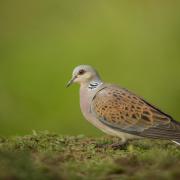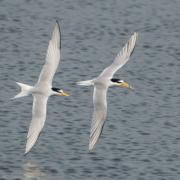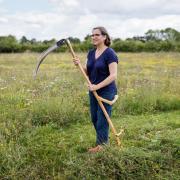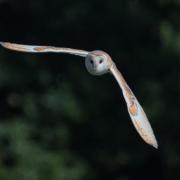Sheep have been linked to Suffolk’s fortunes for centuries. Now they’re helping to revive an endangered bird and inspiring an artist | Words: Richard Negus

A slightly faded black and white wedding photo looks down at me from my bookcase as I write this. The couple in the picture are young and obviously in love.
The bride is a wasp waisted beauty, the groom a lean, athletic looking young man. This timeless scene is perfectly framed by the photographer using the arch of the door to St Edmunds Church in Southwold.
My parents thoughts were doubtless concentrated on other things than sheep as the camera captured their first steps as husband and wife on a blustery September morning in 1956. It was however thanks to wool that their wedding was held in such magnificent surroundings.
St Edmunds church along with Holy Trinity in Long Melford and the Church of St Peter and St Paul in Lavenham are three of the country's most highly prized 'wool churches'. These vast and elaborate 15th century constructions reflected the wealth, importance and piety of a handful of wealthy local patrons, their extravagant displays of affluence, borne on the back of the humble sheep.

Upland East Anglia, particularly Suffolk, boomed between 1450 to 1530 thanks to the wool trade. Local Lords argued for and achieved tariff free trading for Suffolk cloth merchants, while 90 percent of the county's workforce were employed in the wool trade, from shepherding to weaving, spinning to dying.
Such was Suffolk's wool strength that the county was not only able to nearly single-handedly supply the nation's cloth requirements, but also traded widely in Europe and Russia. Merchants' houses reared large, villages transformed into towns with lofty guildhalls erected to proclaim the power of wool.
As sure as night follows day, booms have a bust and this came spectacularly for Suffolk. Henry VIII's addiction to fighting continental wars halted overseas trade.
Simultaneously, Dutch clothiers brought in lighter weight materials that, nearly overnight, made our heavy woollens appear as outdated as a geography teacher's kipper tie. By the 17th century a mere 20 per cent of Suffolk's workers were employed in the wool trade.

To put a final nail in 'King Wool's' coffin the clack, clack of the northern weaving mills of the Industrial Revolution sounded the death rattles of Suffolk's brief fling as the wealthiest county in Britain.
It took generations for Suffolk to recover from this devastating body blow. We returned to an agrarian life, more insular and reliant upon self sufficiency.
Sheep farming remained an important part of our agricultural landscape. The advent of purely arable farms that we see today would have been anathema to our farming ancestors.
Rotational farming saw sheep providing wool and meat, their dung fertilised fields for cropping, their close grazing could clear a weedy field, they suited our soil.

As in most things, Suffolk believed if it wasn't invented here it should have been. Thus the Suffolk sheep was born.
In the early 1800s Southdown rams were crossed with Norfolk Horn ewes to produce a cross that was an improvement on their parents. By 1810 a true type appeared and in 1867 the first Suffolk Flock book was produced, naming every farmer who had a registered pedigree flock.
The Suffolk is an impressive beast with rams and ewes weighing in between 110-160kg. They have black legs and a characteristic open black face. Produced primarily for meat, they also carry a fine close fleece.
Being excellent mothers and of steady temperament has lead to them remaining a popular breed in their own right, or often crossed with faster growing modern breeds to satisfy ever impatient supermarket buyers.
I live near a farmer, Bill James, whose flock of Suffolks is the second oldest in the world. The title of senior boy goes to the Hollesley Bay Flock. The James family's Ashbocking prefix has graced the pages of the Suffolk Flock book since the 1890s.
Bill farms at Winston, just outside Debenham, a village that boasts magnificent beamed merchants' houses and a guildhall from the wool boom era. Now in his 80s, and somewhat less steady on his feet, Bill tells of moving his flock from the grazing at Ashbocking to Winston without the aid of a dog.

He would walk in front of the flock, with his uncle driving them from behind, along what is now the rather busy B1077 past Helmingham Hall. He is passionate and knowledgeable about the breed, having not only judged at county shows but also travelling around the country judging flocks for the prestigious annual national award.
In his wonderful old farmhouse kitchen Bill showed me photographs of the flock in the 1940s with Victor Green, his father's shepherd, proudly exhibiting a parcel of nine pristine ewes, the stamp of which has barely changed from those who graze his land today.
The Ashbocking flock is a fraction of the size it once was. Bill keeps them on knowing that they lose money, but tradition dies hard here. The two rams he retains are prized by breeders and their ancient bloodlines are used throughout the country still. His two prize rams also fulfil another vital yet surprising role, that of conservationist.
I am involved with a small conservation project at Winston, where a wonderful smallholder called Brian Branch is trying to increase the number of farmland birds on his 20 acres of old grassland.
Two particular birds we are trying to encourage to return are the ground nesting nightingale and the grey partridge.
By using Suffolk sheep to graze the margins prior and post the nesting period the tussock grass that these red-listed birds require is naturally maintained, while the inevitable dung increases insect life that the grey partridges feed upon.

Today's lack of mixed farming is one reason for the grey partridge's decline and it's fascinating to see the return of Suffolk's most iconic game bird thanks in-part to the county's own breed of sheep.
Suffolk Sheep Society - suffolksheep.org
Art you can snuggle up to
Our unique wool towns and churches draw admiration from tourists, while the Suffolk sheep is annually paraded and appraised at the Suffolk Show, reminding us that our county's history is intrinsically linked with that of the sheep.

There is, however, another unsung throwback of our wool heritage alive and well in Long Melford. Katie Green is a weaver.
She trained in surface pattern design at Barnsley College of Art but came to the conclusion after graduating there was little call for her skills in the workplace. After jobs as varied as selling diamond cutting blades to running her own homes and gardens shop, she had a recession inspired epiphany which led to her revisiting her training and becoming a full time craftswoman.
The beauty and drama of the Suffolk coast and heathland has inspired a multitude of artists. Katie also found herself drawn by this siren call to the sea and started painting scenes of Aldeburgh and Dunwich in oils.
Sensibly, she realised that to try to make a living by selling paintings in this flooded market would be a short trip to penury. Instead she decided to use her skills with the loom to 'paint' using wool as her medium.
I visited her at her studio in Long Melford, having first seen her work at a craft fair held at Blackthorpe Barn at Rougham.
When initially viewing one of Katie's woven pictures from a distance, your brain tells you that this must be an oil painting.
Slivers of light dance on an Aldeburgh sea, the haze of heather pollen hangs in the air over Dunwich Heath. It is only when you stand close enough to touch that you realise this is a woven fabric, not paint on canvas.
The entire process of design to finished article can take this smiling and talented woman a year to complete. Much of Katie's woven pictures are turned into cushions, meaning you not only have a beautiful artwork in your sitting room, you can even snuggle up with it.
The weaving is all done on a hand loom. Up to five twists of naturally dyed woollen yarn are combined, the shuttle comes down and as if by magic a dune or shingle beach starts to appear in front of your eyes. To achieve the greys and browns Katie uses undyed natural wool.
It is by using this medium of something utterly organic that so successfully captures the earthiness of our wildest Suffolk landscapes. Our county's history is woven in wool and Katie's weaving reflects that heritage. I urge you to seek out her work, it is sublime.
Katie Green- katiegreen.info



























